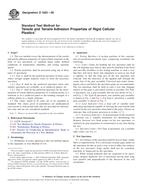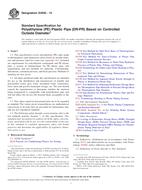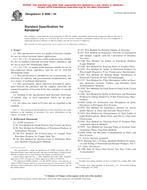Note 1 – The method of testing for the stress relaxation of plastics has been withdrawn from this standard, and the responsibility has been transferred to Practice D 2991.
1.1 These test methods cover the determination of the time dependence of stress (stress relaxation) in materials and structures under conditions of approximately constant constraint, constant environment, and negligible vibration. In the procedures recommended, the material or structure is initially constrained by externally applied forces, and the change in the external force necessary to maintain this constraint is determined as a function of time.
1.2 Specific methods for conducting stress relaxation tests on materials subjected to tension, compression, bending and torsion stresses are described in Parts A, B, C, and D, respectively. These test methods also include recommendations for the necessary testing equipment and for the analysis of the test data.
1.3 It is recognized that the long time periods required for these types of tests are often unsuited for routine testing or for specification in the purchase of material. However, these tests are valuable tools in obtaining practical design information on the stress relaxation of materials subjected to the conditions enumerated, and in investigations of the fundamental behavior of materials.
1.4 Units – The values stated in inch-pound units are to be regarded as standard. The values given in parentheses are mathematical conversions to SI units that are provided for information only and are not considered standard.
1.5 This standard does not purport to address all of the safety concerns, if any, associated with its use. It is the responsibility of the user of this standard to establish appropriate safety and health practices and determine the applicability of regulatory limitations prior to use.
13.1 This test method covers the determination of the time-dependent decrease in stress in a specimen subjected to an uniaxial constant tension strain under conditions of uniform environment and negligible vibration. It also includes recommendations for the necessary testing equipment.
22.1 This test method covers the determination of the time-dependent decrease in stress in a specimen subjected to a long duration, uniaxial, constant compression strain in a uniform environment and negligible vibration. It also includes recommendations for the necessary testing equipment.
30.1 This test method covers the determination of the time-dependent decrease in stress in a specimen subject to long duration, constant bending strain, in a uniform environment, and negligible vibration. Recommendations for some typical test equipment are included. Methods included are only those in which the outer fiber strain is essentially uniform in the test section.
39.1 This test method covers the determination of the time-dependent decrease in torsional stress in a specimen subjected to long duration, constant torsional strain in a uniform environment and negligible vibration. Recommendations for some typical test equipment are included. The test method applies when the outer fiber strain is essentially uniform in the test section.
Product Details
- Published:
- 05/01/2008
- Number of Pages:
- 13
- File Size:
- 1 file , 230 KB
- Redline File Size:
- 2 files , 430 KB


